

 |
|
Belgrade Fortress stands on top of a cliff overlooking the confluence of the Sava and the Danube. This is the last raised ground in the Balkan Peninsula before the vast stretch of flatland of the Pannonian Basin, extending all the way to Central Europe. The Fortress controls the access to the Pannonian Basin and the navigation on the Sava and the Danube, a position of outstanding strategic importance, accounting for its role as a border fortress throughout much of its history. It served
to guard the border between the Roman Empire and barbarian lands across the Danube and the border between the Ottoman and Austro-Hungarian Empires, to name a few, which |
|
|

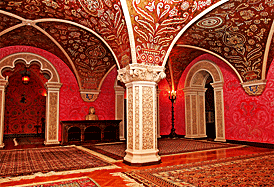

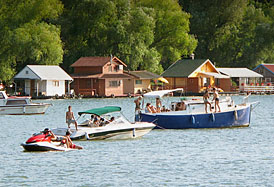

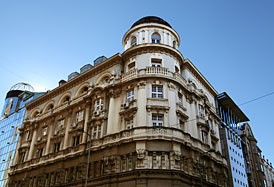

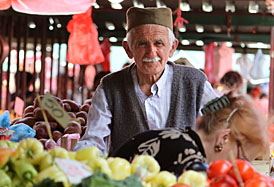

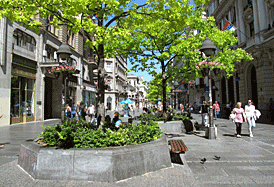

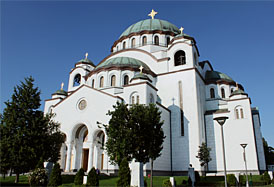





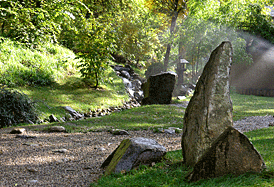

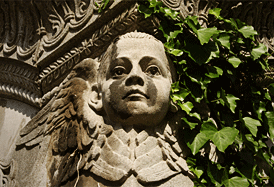
|
|
explains why it was so often destroyed, rebuilt and redesigned. The Romans were the first to build a fort at this site in the late 1st century as the HQ for the IV Roman Legion - Flavia Felix. Its remnants are barely visible today. Belgrade Fortress consists of the Upper Town, Lower (or Water) Town and Kalemegdan Park. The present layout of the Fortress took shape in the late 18th century, but there used to be many more buildings within its walls that had perished in different battles. You can
explore Belgrade’s history here, and the map of the Fortress here. |
 |
|
The UPPER TOWN is in the heart of the fortress, it was Belgrade’s last line of defence and the place of residence of the city commanders. In the days of Roman Empire it was rectangular in shape, and although it grew substantially in the Middle Ages, its walls remained parallel, with numerous turrets for archers. With the emergence of artillery weapons, the Upper Town expanded further and was fortified with a new system of defensive walls with triangular ravelins and bastions. Today these ramparts
conceal many secluded spots for couples in love. The most recognisable attraction in Upper Town is The Victor, the symbol of Belgrade, a male figure cast in bronze, with a sword in his right hand and a pigeon in his left. The sculpture is 14m high and is mounted on a stone |
pedestal, facing Zemun. It is the work of Ivan Meštrović, unveiled in 1928, to commemorate the 10th anniversary of breaching the Salonika Front, a great victory achieved by Serbian Army in the WWI. It was originally intended to be placed in Terazije Square, but the idea of having a realistic presentation of a nude male in the centre of the city caused a public outcry. The plateau around The Victor commands some of the loveliest views of sunsets you can enjoy in the centre of any
capital city in Europe. It also contains a scale model of the castle built by Despot Stefan Lazarević’s in Upper Town in early 15th century (destroyed in a huge explosion of a gunpowder magazine in 1690).
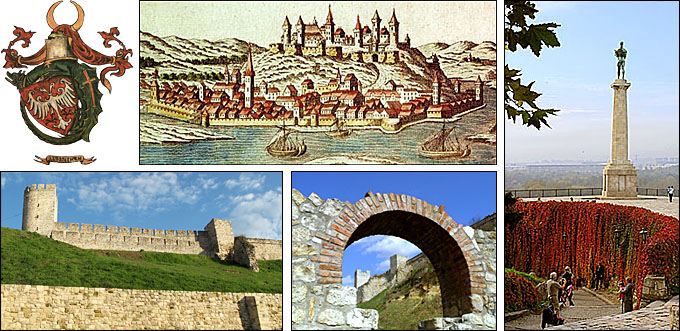
Despot Stefan Lazarević (1377-1427), a knight and a poet, made Belgrade the capital of all Serbian lands and dedicated it to the Most Holy Virgin. One of the best educated men of his times, he was also a formidable warrior who excelled in many battles and was among the most distinguished knights of the Order of the Dragon. Despot’s Gate is the best preserved part of his medieval castle, built in the first half of the 15th century. It was the main gate to the Upper
Town and had a drawbridge. The tower adjoining the gate houses today the Astronomical Observatory. General public is occasionally allowed to use its telescopes to observe the celestial bodies (enquiries number: 3032-133). The north ramparts of the Upper Town are the favourite spot of the Belgrade young for basking in the sun with a guitar and beer or for romantic declarations of love against a backdrop of breathtaking views.
 |
Zindan-Gate was built in the middle of the 15th century and was the best fortified entrance into the fortress. Its vaults served as a dungeon. Just opposite is “Kalemegdan Terrace” restaurant, a good place for rest with splendid views of medieval ramparts and the Danube river. Do not be put off by the formalities of the hostesses at the reception, they will find you a table even without a reservation, however on weekends the restaurant is occasionally closed for private parties, usually the weddings.
The park in the Upper Town is home to Türbe (tomb) of Silahdar Damat Ali Pasha, a Grand Vizier of the Ottoman Empire, who was mortally wounded in a battle against Austro-Hungarian forces led by Prince Eugene of Savoy at Petrovaradin. Two Ottoman commanders of the Belgrade Fortress were also buried here. Just inside the north-west ramparts, next to the Defterdar’s Gate, is the Fountain of Sokollu Mehmed Pasha, a Grand Vezier of Serbian origin. He had served under three Ottoman Sultans
(including Suleiman the Magnificent who had managed to seize Belgrade from the Christians). Opposite the fountain there used to be the main mosque in the Upper Town.
Roman Well is an intriguing structure, about 60m deep (10m of which are below the Sava bottom) and 3,40m wide, surrounded by many grisly legends. It took its present shape during the Austrian rule in the early 18th century. A double spiral staircase leads from its top to the water level. |
|
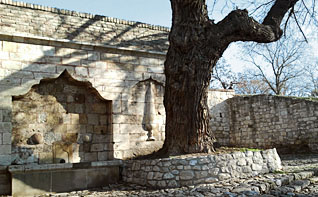
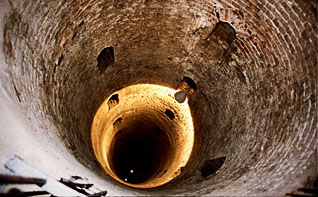 |
This was the stage of probably the most cruel punishment that ever was meted out in the history of the fortress. The Upper Town also contains the Military Museum and the first Masonic temple in Belgrade, which presently serves as the Gallery of the Natural History Museum.
Ružica Church is dedicated to the nativity of the Holy Mother of God. It is the oldest church (that still stands on the same site) in Belgrade. An earlier church of the same name had stood on its site from the days of Despot Stefan Lazarević until it was demolished in the Ottoman conquest of 1521. The present church was initially used as a gunpowder magazine. It was converted into a military church in 1867, when Serbs took over the fortress. Severely damaged in Austrian bombing of the WWI, it
was rebuilt in 1925, when spent shells and bullet casings that had demolished the church were used to cast 3 brass chandeliers, now hanging inside the church (swords and bayonets were also added). In front of the church you can see sculptures of two Serbian warriors: a spearman from the times of Emperor Dušan and a WWI infantry soldier.

The present Church of St. Petka (Parascheva) was built in 1937 above an ancient cave church with a miraculous spring. The relics of St. Petka, much venerated by Belgraders, were kept in this church until 1521, when Sultan Suleiman the Magnificent took them to Constantinople following the capture of Belgrade. The church keeps a fragment of her relics (two fingers). The bones of the defenders of Belgrade (1914-1915) found while the church was being built were laid in the nearby Ossuary located below
Jakšić’s Tower.

LOWER TOWN: during the Middle Ages, this was a thriving settlement with many houses, churches, squares and a market, encompassed by thick walls. There was a harbour for merchant vessels and warships. During a siege, a heavy chain would be drawn across the harbour mouth to block the entry. Nearly all buildings of the Lower Town were swept away in various sieges and bombings. Their ruins are covered by a large lawn, a site of various events and a popular hang-out of dog owners. The few buildings that
remain include Charles VI Gate, raised in 1736 to glorify the Habsburg Emperor whose forces conquered Belgrade in 1717 (built in baroque style, it has the character of a triumphal arch), the Turkish Hamam from late 18th century, which today houses the Planetarium of Ruđer Bošković Astronomical Society, remains of the See of the Metropolitan Bishop of Belgrade...
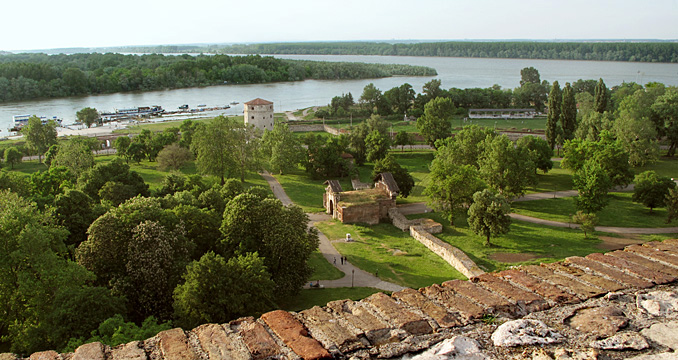
Gunpowder Magazine (Barutana) is also here, carved out in a rock below the Fortress and walled in. Built by Austrians in 1720, today it houses the Roman stone statues, sarcophagi and altars found in Belgrade and its neighbourhood, dating from the 1st to the 4th century AD (at which time, there was a temple to God Mithra below the present gunpowder magazine). The exhibits include “Jonah’s Sarcophagus”, the oldest artefact with Christian motifs |
found in Belgrade territory. Open: Tue-Sun. 12-17.
Nebojša Tower was built in 1460 as a cannon tower. During the Ottoman rule it was turned into a dungeon and torture chamber where many freedom fighters met violent death, including the famous Greek revolutionary and poet Rigas Feraios who was killed here in 1789. The tower has recently been renovated and you can no longer see the authentic ambiance. Multimedia applications on 4 floors offer various information about the tower, uprisings against the Ottoman Empire and Rigas Feraios. The adjoining
building houses a souvenir shop, info centre and toilets. Open: Tue-Sun. 10-20 (wintertime 10-18). Admission fee: 300 RSD, students and children 150 RSD. |
|
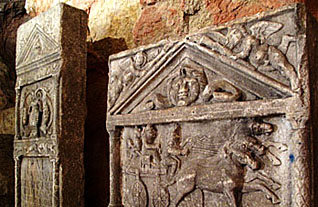 |
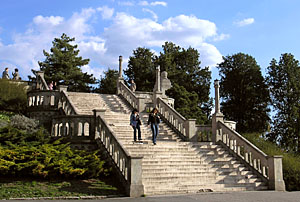 |
|
KALEMEGDAN PARK was developed as late as 19th century on a plateau between the Belgrade Fortress and settlements that was kept bare in order to better spot the approach of the enemy. During the Ottoman rule, it was also the site of a slave market and a scaffold. The park features numerous sculptures, a bandstand, "Cvijeta Zuzorić" Art Pavilion, the Zoo, amusement park and a playground for children. It is the favourite haunt of chess players, squirrels and couples in love. The main entrance
from Kneza Mihaila St is lined with souvenir stands. We recommend a stroll along the promenade above the Sava bank, from the Little Staircase opposite the French Embassy (designed in 1903 by Jelisaveta Načić, the first lady architect in Serbia) to the King’s Gate, below the Victor
|
monument. In the course of your stroll you can enjoy views of New Belgrade and bridges over the Sava. On the other side of the river, between Gazela Bridge (red in colour) and the old railway bridge (lattice girder railway bridge) is the site from which the attack on Belgrade was launched on 28 July 1914, which marked the beginning of the First World War (the opposite bank belonged to Austro-Hungarian Empire until 1918).
The Zoo was established in 1936. It is a great place to visit, largely owing to the efforts of its present director, Vuk Bojović, and his staff. It enjoys international fame as the place where many species of animals reproduce successfully, including white lions. In addition to white lions, its greatest attractions are white tigers and white kangaroos. The Zoo is home to the officially oldest alligator in the world named Muya. His exact age is unknown - he arrived in Belgrade in 1937 when he was already
an adult. He has survived two major bombings in WW2 (1941 and 1944), which destroyed most of the Zoo and its inhabitants. A special attraction for children is the Baby Zoo, where baby animals born in the Zoo are raised. Open: Mon-Sun. 8-20.
 |
|















![]()